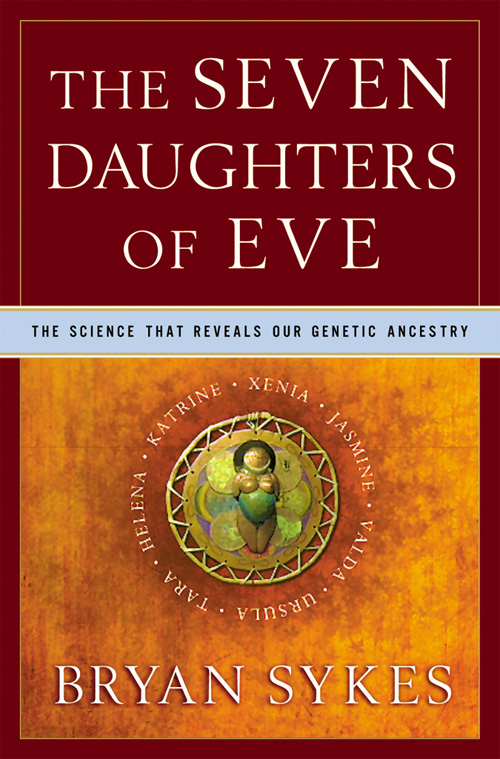« John J. Steadman of Iowa | Main | Ichabod Hall of Enfield, CT »
Tracing mtDNA: The Seven Daughters of Eve
By Kathryn Hall | March 1, 2010

While the extraordinary book The Seven Daughters of Eve by Oxford University professor of genetics Bryan Sykes was published ten years ago, it has just recently come to my attention. I suppose it was inevitable, or at least organic that when I found, at last, an exact 37 marker DNA match to my father, proving my many years of research, that my focus would turn to include the maternal counterpart, mtDNA.
I will not assume that all readers will know that DNA is the genetic material passed from father to son. But most doing research are aware that most of genealogy, to date, is built almost purely upon a patriarchal paradigm, following the data of the lives of fathers and sons. Indeed, when a particular family line “ends” with only daughters the research often comes to a screeching halt, and the line, it is declared has “daughtered out.”
But then there are the mothers, who are much more work to trace, due to the current and longtime practice of women surrendering their “maiden” names and trading for their husbands’ and thus obscuring their histories forever.
Except for this: mtDNA. For the mothers, in fact, pass along mtDNA to both their sons and daughters. And their daughters, in turn pass along to their sons and daughters. But only their daughters will pass along mtDNA to their sons and daughters. And so it is the daughter line that determines the fate of the history of a family if that is the lens through which we choose to look.
And an interesting fact about mtDNA. It really is much more stable. Over time it is not subject to the many mutations we find in DNA.
“..although the mitochondrial mutation rate seems incredibly slow, it is fortunately just about right for studying human evolution over the last hundred thousand years–which is when most of the action happened.” ~Bryan Sykes
And why would this be of interest? Because through the slow changing mtDNA of mothers, passed along to their children, we have the magical possibility of determining a history that even ten years ago seemed an impossibility. We can discover through a relatively unchanging mtDNA of an individual the geographic likelihood of where an individual’s ancestors came from. More than that, we can discover their tribe, their clan, their original human family. The Clan Mother.
“I slowly realized that we held in our hands the power to reconstruct the maternal genealogy of the whole world.” ~Bryan Sykes
And for those of us with other histories, perhaps just as dramatic and difficult, through mtDNA we can trace our early early roots, back to the earliest common ancestor whose lines did not become extinct. Author Bryan Sykes, Oxford geneticist, has identified seven women who did live on planet Earth, whose lines not only survived through the passage of mtDNA to their daughters (who passed it along), who are the source mothers of a profoundly large number of those with European roots.
Researching this book I’ve discovered there are folks out there who actually criticized Sykes’ spinning stories around each of these women, who, again, really did exist. But I for one thought it was both creative and authentic that he carefully constructs a story for each woman based on what was known about the cultures of the women when they lived on planet Earth, i.e, through anthropological and archeological discoveries of those particular times. I found that tactic infinitely more interesting than a more than likely dry boring description of the pertinent culture at hand. Thus we get passages like this:
Helena spent her childhood in this landscape, helping her mother comb the woods for wild mushrooms and toadstools, or wading in the brackish lagoons in search of oysters. Her father patrolled the woods alone, on the lookout for small dear and other mammals.
Or:
Xenia was born in the wind and snow of late spring. Even though it was already April, the snow that covered the land in winter was still on all but the lowest ground and lay in a thick and filthy slush around the campsite. Xenia herself was born in a round hut, about three metres in diameter, whose frame was constructed almost entirely of mammoth bones.
These are hardly passages one would expect to read in a book about mtDNA, and therefore I think Sykes, obviously a fine writer, made a good choice for both himself and his readers. Bravo.
I highly recommend The Seven Daughters of Eve, a fascinating introduction to mtDNA. My prediction is that you will not be able to put the book down and you will walk away unexpectedly enriched and wanting more.
~KH
Topics: Book Corner | 4 Comments »


March 1st, 2010 at 3:12 pm
Fascinating! Thanks for the continued great work, and excellent book recommendation!
March 1st, 2010 at 4:26 pm
Thank you so much! I hope you read and enjoy the book!
~KH
March 2nd, 2010 at 8:13 am
Years ago I read this book, and recommend it to my husband. He’s a real MIT engineer and never really was interested in genealogy until the moment he read this book. We had our DNA tested, and now he watches all the DNA programs on National Geographic channel and PBS, his mtDNA is the same as mine although his family is from Spain and I’m a New England Yankee with Mayflower roots. We’re both descended of the “Helena” you quoted above. Brian Sykes was in Boston last year and spoke at NEHGS. I wish I could have attended.
March 2nd, 2010 at 12:17 pm
Heather, thank you for sharing this story. I can well understand. It’s lighted a new fire under me as well from many aspects. How interesting you share the same mtDNA. So if you went back far enough, same roots? Apparently. Fascinating! ~KH